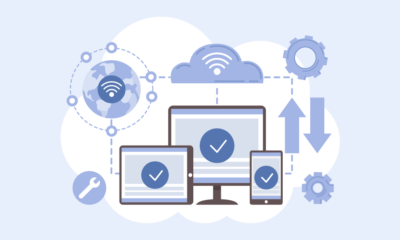Tech
Software Development: Way to code world

Introduction to Software Development
In the digital age, software development is the backbone of nearly every innovation and technology we interact with daily. From the apps on our smartphones to the systems running complex industrial operations, software development is the process that brings these ideas to life. But what exactly is software development, and why is it so crucial today?
Software development is the process of designing, coding, testing, and maintaining applications or systems that perform specific tasks on computers or other devices. It’s not just a process, it’s a catalyst for change, a driver of technological progress. The importance of software development in today’s world cannot be overstated—it’s the engine driving technological progress, enabling businesses to operate efficiently, and enhancing the way we live and work.
The Software Development Life Cycle (SDLC)
One of the fundamental concepts in software development is the Software Development Life Cycle (SDLC). This structured process helps developers create high-quality software that meets customer expectations and is completed within time and budget estimates.
What is SDLC?
The SDLC is a series of stages that a software project goes through, from initial planning to final deployment and maintenance. It provides a systematic approach to building software, ensuring that all aspects of development are addressed.
Phases of SDLC
- Planning: This initial phase involves understanding the project requirements, determining its scope, and planning the necessary resources and timelines.
- Analysis: Here, the requirements are analyzed in detail to identify the features the software must have. This phase also involves feasibility studies.
- Design: This phase creates the software’s architecture and design, focusing on how the software will meet the requirements.
- Implementation: This is where the actual codings take place. Developers write the code according to the design specifications.
- Testing: The software is rigorously tested to identify and fix any bugs or issues.
- Deployment: The software is deployed to the production environment once tested and refined.
- Maintenance: After deployment, the software needs ongoing maintenance to fix issues, update features, and improve performance.
Types of Software Development
Software development is not a one-size-fits-all discipline. It spans various types depending on the end product being developed.
Web Development
This involves creating websites and web applications that run on browsers. Web developers work on applications’ front-end (user interface) and back-end (server-side logic).
Mobile App Development
With the proliferation of smartphones, mobile app development has become a significant area of software development. This type focuses on creating applications for mobile devices, using languages and frameworks like Swift for iOS or Kotlin for Android.
Desktop Application Development
These are traditional software applications that run on personal computers. Examples include word processors, media players, and graphic design tools.
Embedded Systems Development
This involves writing software for specialized computing devices that perform specific tasks, such as automotive systems, medical devices, or household appliances.
Game Development
Game development is a specialized field that combines creativity with technical skills to create interactive games for various platforms, including consoles, PCs, and mobile devices.
Cloud Development
Cloud development focuses on creating software applications that run in cloud environments, offering scalability and remote accessibility.
Popular Software Development Methodologies
The approach to software development can vary widely, with several methodologies offering different frameworks for managing the process.
Waterfall Model
The Waterfall Model is a linear approach in which each phase of the SDLC is completed before proceeding to the next. It’s straightforward but can be rigid and inflexible.
Agile Methodology
Agile is a more flexible and iterative approach. It focuses on collaboration, customer feedback, and small, rapid releases to continuously improve the product.
Scrum Framework
Scrum is a subset of Agile that emphasizes teamwork, accountability, and iterative progress toward a well-defined goal. It uses short cycles called sprints.
DevOps Approach
DevOps integrates software development (Dev) and IT operations (Ops) to shorten the development lifecycle and continuously deliver high-quality software.
Lean Software Development
Lean focuses on delivering value to the customer by eliminating waste, improving efficiency, and optimizing resources.
Kanban Method
Kanban is another Agile framework that visualizes the work process, helping teams manage workflow and improve efficiency.
Critical Programming Languages in Software Development

Software-Development
The choice of programming languages can significantly impact the development process. Here are some of the most widely used languages in the industry:
JavaScript
JavaScript is the language of the web, essential for creating interactive web pages and applications.
Python
Python is known for its simplicity and versatility, making it famous for web development, data analysis, artificial intelligence, and more.
Java
Java is a powerful, object-oriented language widely used for building large-scale enterprise applications.
C#
C# is a language developed by Microsoft. It is commonly used to develop Windows applications and games using the Unity engine.
C++
C++ is an extension of the C programming language for system/software development, game development, and performance-critical applications.
Swift
Swift is Apple’s language for iOS and macOS development, and it is known for its speed and safety features.
Ruby
Ruby is famous for web development, especially with the Ruby on Rails frameworks, simplifying the process of building complex web applications.
Tools and Technologies Used in Software Development
Effective software development requires various tools and technologies to streamline the process and ensure quality.
Integrated Development Environments (IDEs)
IDEs like Visual Studio, IntelliJ IDEA, and PyCharm provide comprehensive code environments for writing, testing, and debugging.
Version Control Systems of Software Development
Tools like Git and Subversion are essential for managing changes to code and collaborations with other developers.
Continuous Integration/Continuous Deployment (CI/CD) Tools
CI/CD tools like Jenkins and GitLab CI help automate the process of testing and deploying software, making it easier to release updates quickly and reliably.
Database Management Systems of Software Development
Databases like MySQL, PostgreSQL, and MongoDB store and manage the data that applications need to function.
Cloud Platforms
AWS, Microsoft Azure, and Google Cloud provide the infrastructure for hosting applications and managing resources globally.
The Role of a Software Developer
Software developers require a blend of technical knowledge, problem-solving skills, and creativity.
Skills Required for Software Development
A solid understanding of programming languages, algorithms, and data structures is essential. Developers must also know software development methodologies, tools, and best practices.
Responsibilities of a Software Developer
Developers are responsible for writing clean, efficient code, debugging issues, collaborating with team members, and continuously learning to keep up with new technologies.
The Importance of Problem-Solving Skills in Software Development
Software development is fundamentally about solving problems. Developers must be able to think critically and creatively to find solutions to complex challenges.
Challenges in Software Development
The software development journey is fraught with challenges that can complicate the process.
Managing Project Complexity
As software projects grow in size and scope, managing their complexity becomes a significant challenge. This requires careful planning, documentation, and communication.
Keeping Up with Rapidly Evolving Technologies
The software industry evolves rapidly, constantly emerging new languages, frameworks, and tools. Staying updated is crucial but challenging.
Ensuring Security and Privacy
With increasing concerns over data breaches and privacy violations, developers must prioritize security throughout development.
Meeting Deadlines and Budget Constraints
Balancing time and resources while delivering a high-quality product is a perennial challenge in software development.
Collaboration and Communication Issues
Effective communication and collaboration among team members are critical, especially in large, distributed teams.
Best Practices in Software Development
Adhering to best practices can significantly improve software development’s quality and efficiency.
Writing Clean and Maintainable Code
Clean code is easier to understand, maintain, and extend. Following coding standards and documenting the code is vital.
Embracing Test-Driven Development (TDD)
TDD is a practice where tests are written before the code, ensuring the software meets its requirements.
Regular Code Reviews in Software Development
Code reviews help catch issues early, share knowledge among team members, and ensure adherence to coding standards.
Continuous Learning and Improvement
The best developers are lifelong learners, continually improving their skills and adapting to new technologies.
Effective Documentation
Good documentation helps others understand how the software works and how to maintain it, ensuring its longevity.
Future Trends in Software Development
The future of software development looks promising, with several trends set to shape the industry.
Artificial Intelligence and Machine Learning Integration
AI and machine learning are becoming integral to software development, enabling more innovative applications and automation.
The Rise of Low-Code/No-Code Development Platforms
These platforms allow non-developers to create applications, democratizing software development and speeding up the process.
Increased Focus on Cybersecurity
With cyber threats rising, there will be a greater emphasis on building secure software from the ground up.
Growth of Edge Computing
Edge computing, which involves processing data closer to where it’s generated, is set to reduce latency and improve application efficiency.
Expansion of the Internet of Things (IoT)
As more devices become connected, IoT development will continue to grow, leading to new software challenges and opportunities.
The Impact of Software Development on Business
Software development is not just a technical process; it’s a business enabler.
Enhancing Operational Efficiency
Software automates and streamlines business processes, reducing manual work and errors.
Enabling Innovation and Competitive Advantage
Businesses that leverage software development can innovate faster, creating new products and services that set them apart from competitors.
Driving Digital Transformation
Software is at the heart of digital transformation, helping companies transition to digital-first operations.
Supporting Data-Driven Decision Making
Software tools enable businesses to collect, analyze, and act on data, leading to better decision-making and outcomes.
The Role of Open Source in Software Development
Open-source software has become a cornerstone of modern development.
What is Open Source Software?
Open-source software has code that anyone can inspect, modify, and enhance.
Benefits of Using Open Source in Software Development
Open-source projects foster collaboration, innovation, and cost savings. They also provide transparency and security.
Popular Open Source Projects in Software Development
Some well-known open-source projects include the Linux operating system, the Apache web server, and the Python programming language.
Software Development for Startups
For startups, software development is both an opportunity and a challenge.
Importance of MVP (Minimum Viable Product)
Startups often begin with an MVP—a simple version of their product that can be released quickly to gather user feedback and iterate.
Balancing Speed and Quality
Startups must balance the need for rapid development with the importance of delivering a high-quality product.
Cost-Effective Development Strategies
Using open-source tools, outsourcing, and adopting agile methodologies can help startups keep development costs under control.
How to Start a Career in Software Development
Are you interested in becoming a software developer? Here’s how to get started.
Educational Pathways
A degree in computer science or a related field is joint, but many developers are self-taught or come from non-traditional backgrounds.
Building a Portfolio in Software Development
A strong portfolio showcasing your projects is essential for landing a job. Contribute to open-source projects, work on personal projects, and participate in coding challenges to build a robust portfolio.
Networking and Community Involvement
Join developer communities, attend conferences, and participate in online forums. Networking with other developers can open doors to job opportunities and provide valuable insights into the industry.
Certifications and Continued Education in Software Development
While only sometimes necessary, certifications in specific technologies or methodologies (like AWS, Microsoft, or Agile) can enhance your resume. Continuous learning through online courses, boot camps, and workshops is crucial to staying competitive.
Conclusion
Software development is a dynamic and ever-evolving field crucial to our modern world. It is at the core of innovation and efficiency, from the devices we use daily to the complex systems that drive industries. The journey from an idea to a fully functioning software product involves various stages, methodologies, and tools, each contributing to the outcome.
Whether you’re an aspiring developer or a business leader, understanding software development fundamentals is essential. This field has many challenges, but they can be overcome with the right skills, tools, and mindset. As we look to the future, the integration of emerging technologies like AI, the rise of new development platforms, and the ongoing importance of cybersecurity will continue to shape the software development landscape.
The opportunities are vast for those considering a career in this exciting field. By building strong foundations, staying updated with the latest trends, and continuously honing your skills, you can carve out a successful career in software development.
FAQs of Software Development
- What is the most popular programming language for software development?
- JavaScript is currently one of the most popular programming languages for web development. Its versatility and wide adoption make it a crucial language for developers.
- How long does it take to become a software developer?
- The time it takes to become a software developer varies. A traditional computer science degree takes about four years, but many people enter the field through coding boot camps or self-study, which can take anywhere from a few months to a year.
- What are the most common challenges faced in software development?
- Common challenges include managing project complexity, staying updated with new technologies, ensuring security, meeting deadlines, and maintaining effective team communication.
- How can I stay updated with the latest trends in software development?
- Staying updated involves continuous learning through online courses, attending conferences, following industry blogs, participating in developer communities, and experimenting with new technologies.
- Is it necessary to learn multiple programming languages?
- While it’s possible to specialize in one language, learning multiple programming languages can make you more versatile and open up more opportunities. Different languages are suited to varying types of development, so having a broader skill set can be beneficial.
Tech
Is It the Right Time to Start PPC? 5 Expert Tips to Guide You

Pay-per-click advertising can be a great avenue for any business to drive targeted traffic and upscale conversions. It can easily become time-consuming with fewer results than expected if the timing is wrong. Understanding when to start your PPC campaigns can help you attain a better ROI. The following are five tips that will tell you when the right time is to create and launch your perfect pay-per-click campaign.
-
Assess Your Business Goals
Before running a PPC campaign, make sure that your business objectives align with the possible outcomes of the campaign. PPC is most effective when applied to achieve definite goals: website traffic increase, generating leads, and driving sales. If your goals are not clear or defined vaguely, it’s better to refine them before investing in paid ads. Take the time to assess your readiness, including factors such as clarity of target audience, market demand, and your ability to measure campaign performance. A clear alignment between your goals and PPC’s capabilities ensures that you are not jumping in prematurely.
-
Establish a Solid Digital Foundation
Your PPC campaigns are only as strong as your digital infrastructure. Before you begin, make sure your website is optimised for UX: it loads fast, the navigation is clear, and the landing pages are compelling. Also, set up the essential analytics tools that will help you track the performance of your campaign as accurately as possible. Without a solid foundation, even a brilliant PPC strategy might fail to bring in the expected results. Investing in these preparatory steps helps you maximise the effectiveness of your PPC campaigns when you’re ready to launch.
-
Customise Your Approach with Tailored Solutions
Success in running a pay-per-click strategy often depends on just how well your campaigns match up to meet the needs of your particular business. Instead of a one-size-fits-all approach, invest in PPC packages that are customised to your specific goals and audience. By tailoring strategies, targeting is much more exact, ad placement will be better, and it keeps focused on metrics important to your business. Whether it’s picking the correct keywords, crafting personalised ad creatives, or setting the right budget, customised solutions afford the flexibility and control required for effective campaigns.
-
Monitor Your Competition and Market Trends
With PPC, timing is everything, and an important factor is competition. It’s in researching competitor activity and industry trends that one may find valuable insights into market timing. As an example, if your competitors heavily launch their campaigns during peak seasons, this could be the appropriate time to start yours as well, or it could also mean finding a quieter time wherein your ads have better chances of getting views. Keeping yourself updated on market trends will guarantee that you maximise your best opportunities in implementing PPC.
-
Ensure Your Budget is Ready
PPC campaigns require a financial commitment, so it’s crucial to allocate a budget that aligns with your goals. Evaluate your business’s financial position to determine if you can sustain an ongoing PPC strategy without compromising other operational needs. Starting small and scaling up as you see results is a smart approach. Additionally, plan for contingencies such as testing multiple campaigns or reallocating funds to higher-performing strategies. A well-planned budget ensures you don’t overspend and simultaneously optimise your PPC efforts.
In conclusion, PPC advertising has the potential to be a game-changer for businesses ready to take their online visibility to the next level and drive meaningful results. However, starting at the right time with a clear strategy is key to making its potential a reality. Remember that successful PPC is not just about when you start – it’s also about how prepared you are to sustain and scale your efforts.
Tech
Boosting Performance with Nitro Fuel: Tips for RC Enthusiasts

For RC enthusiasts who crave speed, power, and the thrill of a roaring engine, nitro fuel remains a top choice. Unlike electric motors, nitro-powered RC vehicles provide a unique experience, with real combustion engines that replicate the excitement of full-sized cars. However, to truly get the best performance from nitro fuel, it’s essential to understand the intricacies of fueling, tuning, and maintenance. Here’s a complete guide on how to maximize performance with nitro fuel in your RC vehicle.
What is Nitro Fuel?
Nitro fuel, also called glow fuel, is a specially formulated blend used to power RC cars, planes, and boats with combustion engines. It typically contains:
- Methanol: The primary fuel component.
- Nitromethane: Boosts combustion and adds power.
- Lubricants (usually castor or synthetic oil): Keeps the engine lubricated during operation.
The nitromethane percentage in the fuel determines the power output; higher percentages yield more power but can increase wear on the engine. Common blends range from 10% to 30%, with RC cars typically using between 20% and 30% for optimal performance.
Tips for Boosting Nitro RC Performance
With a few key practices, you can maximize both the speed and longevity of your nitro-powered RC vehicle.
1. Choose the Right Nitro Blend
Selecting the right nitro fuel blend is crucial. Beginners might start with lower nitromethane percentages (10-20%), as they are less demanding on the engine. However, advanced users who want high performance typically go for a blend between 20-30% nitromethane. Higher nitro content delivers more power but will also make the engine run hotter, so be prepared for potential adjustments in tuning and maintenance.
2. Keep Your Engine Tuned for Optimal Performance
Tuning is vital for maximizing nitro fuel performance. A well-tuned engine ensures fuel is burned efficiently, giving your RC vehicle the power and responsiveness you need. The two key tuning adjustments are:
- High-Speed Needle (HSN): Controls fuel flow at high speeds. Adjusting the HSN impacts top speed and overall fuel efficiency.
- Low-Speed Needle (LSN): Manages fuel flow at low speeds, affecting acceleration and idling.
To achieve an optimal tune, start by adjusting the HSN, finding a balance where the engine performs smoothly at full throttle without stalling. Then, fine-tune the LSN to ensure smooth acceleration from a standstill. For accurate adjustments, test the vehicle under various loads and conditions.
3. Use a Quality Glow Plug
The glow plug is essential to combustion in nitro RC engines, as it heats the fuel-air mixture for ignition. Performance can vary based on glow plug type:
- Hot Plugs: Best for low-nitro fuel blends (10-20%) and are used in colder weather conditions.
- Medium Plugs: Suitable for most applications and work well with medium nitro blends (20-25%).
- Cold Plugs: Best for high-nitro fuel (30% or higher) and warmer weather.
Regularly inspect and replace glow plugs, especially if you’re experiencing issues with inconsistent engine starts or decreased performance.
4. Maintain Proper Fuel Storage
Nitro fuel is sensitive to temperature and moisture, so proper storage is essential. Exposure to humidity can degrade the methanol, causing performance issues and potential engine damage. Here’s how to keep your nitro fuel in peak condition:
- Store in a Cool, Dry Place: Room temperature is ideal; avoid areas exposed to sunlight.
- Use Airtight Containers: Always seal containers tightly after each use to keep out moisture.
- Avoid Plastic Containers: Use fuel canisters designed for nitro fuel, as some plastics may break down over time.
5. Warm Up Your Engine Before Use
Cold starts can cause unnecessary wear on a nitro engine, as oil and fuel might not circulate properly. To warm up your engine, let it idle for about 30 seconds before pushing it to full throttle. This helps ensure that the engine reaches operating temperature gradually, reducing the risk of strain or damage to internal parts.
6. Run Your Engine at Optimal Temperatures
A nitro engine performs best within a specific temperature range, usually around 200–230°F (93–110°C). Running below or above this range can affect power output and engine life. If you’re pushing your vehicle to its limits, monitor the temperature with an infrared thermometer. If it starts to overheat, slightly enrich the fuel mixture by adjusting the HSN to avoid damaging the engine.
7. Regularly Clean the Air Filter
An RC car’s air filter ensures that only clean air enters the engine, preventing debris from causing damage or clogging. Keeping the air filter clean is essential for consistent performance. Depending on the environment (especially dusty or sandy areas), clean the filter frequently, and replace it if it becomes too worn or clogged.
To clean:
- Remove the Air Filter and gently wash it with a mild cleaner.
- Dry Completely before reinstalling.
- Lightly Oil with a special air filter oil to help trap dust and debris.
8. Practice Proper Engine Shutdown
Properly shutting down a nitro engine can help prevent damage and extend its life. When you’re finished running your vehicle, it’s best to avoid stopping the engine by simply pinching the fuel line, as this can lead to excessive fuel build-up in the carburetor. Instead, stop the engine by using a kill switch or an engine stop tool. After shutdown, consider adding a few drops of after-run oil to the engine to keep internal parts lubricated.
Troubleshooting Common Nitro Fuel Issues
Despite careful preparation, nitro engines may encounter common issues. Here’s how to address a few of them:
- Difficulty Starting: Check your glow plug, fuel lines, and carburetor settings. An old or damaged glow plug is often the culprit.
- Engine Overheating: Verify that your HSN is not set too lean, which causes excess heat. Adjust your tune or give the engine time to cool between runs.
- Loss of Power: This can occur if your air filter is clogged, the glow plug is worn, or your tuning is off. Start with a basic tune-up and ensure components are clean and functional.
The Experience of Nitro-Powered RC Vehicles
For many enthusiasts, the appeal of nitro-powered RC vehicles lies in the realism—the sound, smell, and thrill of a combustion engine. By following these tips for selecting, using, and maintaining nitro fuel, you can unlock maximum performance from your RC vehicle and enjoy an experience that’s both powerful and satisfying.
From proper tuning and fuel storage to selecting the best nitro blend, these tips will ensure your nitro-powered custom RC cars delivers peak performance every time you take it out on the track. Whether you’re a beginner or an experienced enthusiast, nitro fuel can provide the ultimate RC experience when used correctly.
Tech
VeriFace: Precision in Identity Authentication and Face Recognition

In the present computerized world, guaranteeing secure and exact character confirmation is more pivotal than ever. With the ascent of online administrations, organizations and people the same need dependable techniques to affirm personalities. This is where VeriFace becomes an integral factor, offering front-line face recognition innovation that upgrades identity verification processes. In this article, we will investigate how VeriFace uses progressed face verification methods to give exact and trustworthy character validation.
Understanding Face Recognition
At its center, face recognition is an innovation that recognizes or confirms an individual’s personality utilizing their facial elements. In contrast to customary techniques, for example, passwords or ID cards, face recognition uses exceptional natural qualities, making it a hearty answer for identity verification. By investigating facial examples, VeriFace can decide whether an individual’s face matches a put-away picture, giving an elevated degree of exactness and security.
The Importance of Identity Verification
As online exchanges and collaborations increment, so do the dangers of data fraud and misrepresentation. Identity verification is fundamental for safeguarding delicate data and guaranteeing that people are who they are guaranteed to be. Whether it’s getting to a ledger, signing into a solid help, or checking a client’s personality, organizations need dependable arrangements. VeriFace offers a cutting-edge way to deal with face verification, making it more straightforward for associations to safeguard themselves and their clients.
How VeriFace Functions
VeriFace utilizes progressed calculations to perform face recognition rapidly and precisely. The cycle starts when a client presents a photograph or sweeps their face utilizing a camera. The framework catches key facial highlights, for example, the distance between the eyes, the state of the facial structure, and the shapes of the cheeks. These elements make a one-of-a-kind facial mark, which VeriFace then, at that point, looks at against a data set of put-away pictures.
This correlation interaction is direct yet exceptionally compelling. In the event that the facial mark matches a picture in the data set, the framework affirms the singular’s character. This quick and effective technique for face verification upgrades security as well as further develops client experience by lessening the time required for confirmation.
Benefits of VeriFace
1. Upgraded Security
One of the essential advantages of VeriFace is its upgraded security highlights. By depending on face recognition, the framework limits the gamble of unapproved access. Not at all like passwords, which can be neglected or taken, facial highlights are remarkable and hard to reproduce. This biometric check technique guarantees that mainly approved people can get to delicate data.
2. Easy to understand Insight
VeriFace is planned in view of the client. The face verification process is fast and natural, requiring insignificant exertion from clients. With simply a look, people can verify their personality without the requirement for confounded passwords or extensive check processes. This effortlessness urges more clients to embrace biometric arrangements, at last prompting more prominent security.
3. Versatility
One more critical benefit of VeriFace is its versatility. Organizations, everything being equal, can execute this face recognition innovation to improve their safety efforts. Whether a little startup or a huge company, VeriFace can be custom-fitted to address explicit issues, making it a flexible answer for identity verification.
4. Diminished Misrepresentation
By executing VeriFace, associations can fundamentally diminish the gamble of misrepresentation. The precision of face recognition innovation forestalls wholesale fraud and unapproved access. This is especially significant in businesses like banking, medical services, and Internet businesses, where it is vital to safeguard delicate information.
Utilizations of VeriFace
VeriFace has a large number of utilizations across different areas. The following are a couple of models:
1. Monetary Administrations
In the financial area, identity verification is basic for forestalling extortion. VeriFace can smooth out the record opening interaction by rapidly checking a client’s personality through face recognition. This upgrades security as well as further develops consumer loyalty by lessening standby times.
2. Travel and Friendliness
Aircraft and lodgings can use VeriFace for consistent registrations. By coordinating face verification into their frameworks, voyagers can sidestep long queues and partake in a more productive encounter. This innovation can likewise upgrade security at air terminals by guaranteeing that travelers match their tickets.
3. Medical care
In medical services, identity verification is essential for safeguarding patient data. VeriFace can assist medical services suppliers with affirming the personalities of patients rapidly, guaranteeing that clinical records are secure and available just to approved staff.
The Eventual Fate of Face Recognition Technology
As innovation keeps on advancing, the future of face recognition looks encouraging. Advancements in man-made consciousness and AI will additionally upgrade the exactness and dependability of VeriFace. With progressing headways, we can expect much safer and more proficient techniques for identity verification before very long.
End
In our current reality where security is fundamental, VeriFace stands apart as a forerunner in identity verification through its imaginative utilization of face recognition innovation. By giving precise, quick, and easy-to-use arrangements, VeriFace assists organizations with safeguarding delicate data and improving client encounters. As we push ahead, embracing biometric confirmation techniques like VeriFace will be fundamental for shielding our characters in an undeniably computerized scene.
-

 News5 months ago
News5 months agoBrooke Tilli – Bio, Age, Relationships, Career, Net Worth, and Boyfriend
-

 Celebrity4 months ago
Celebrity4 months agoPedro Vaz Paulo: A Life of Redemption
-

 Celebrity4 months ago
Celebrity4 months agoBurak Deniz: The Turkish Heart-Throb
-

 Tech5 months ago
Tech5 months agoCloud Computing: Enabling IT Innovation
-

 News5 months ago
News5 months agoDefine a Offshore Accident Lawyer
-

 Tech4 months ago
Tech4 months agoSaaS Integration: Cloud-Based Software
-

 Business4 months ago
Business4 months agoJanitor AI: Future of Auto Maintenance
-

 News5 months ago
News5 months agoAI Deepfake Threaten to Global Elections. No One Can Stop Them.



